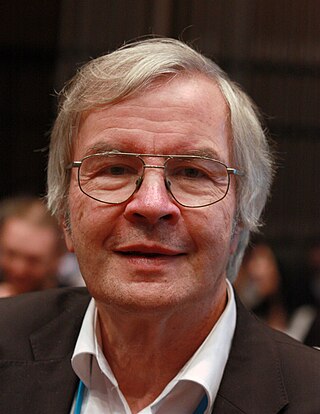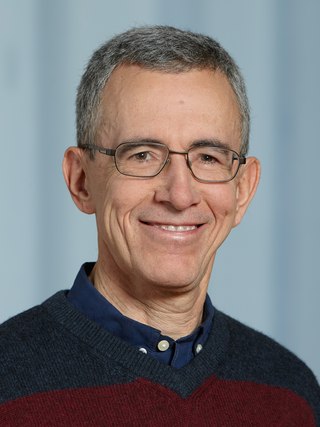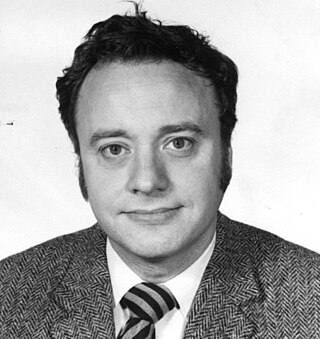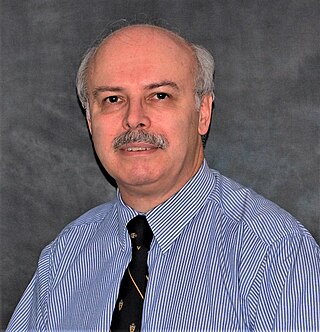
Theodor Wolfgang Hänsch is a German physicist. He received one-third of the 2005 Nobel Prize in Physics for "contributions to the development of laser-based precision spectroscopy, including the optical frequency comb technique", sharing the prize with John L. Hall and Roy J. Glauber.
Federico Capasso is an applied physicist and is one of the inventors of the quantum cascade laser during his work at Bell Laboratories. He is currently on the faculty of Harvard University.

Ataç İmamoğlu is a Turkish-Swiss physicist working on quantum optics and quantum computation. His academic interests are quantum optics, semiconductor physics, and nonlinear optics.
Roberto D. Merlin is an Argentine physicist and Peter A. Franken Collegiate Professor of Physics and Professor of Electrical Engineering and Computer Science at the University of Michigan. He is known, among other things, for his work on quasiperiodic superlattices, squeezed phonons, and, most recently, for the discovery of "superfocusing", a method for creating lenses that can surpass the diffraction limit without using negative refraction materials.

Robert Louis Byer is a physicist. He was president of the Optical Society of America in 1994 and of the American Physical Society in 2012.

David Jeffrey Wineland is an American Nobel-laureate physicist at the National Institute of Standards and Technology (NIST). His work has included advances in optics, specifically laser-cooling trapped ions and using ions for quantum-computing operations. He was awarded the 2012 Nobel Prize in Physics, jointly with Serge Haroche, for "ground-breaking experimental methods that enable measuring and manipulation of individual quantum systems".
Yuen-Ron Shen is a Chinese physicist. He is a professor emeritus of physics at the University of California, Berkeley, known for his work on non-linear optics. He was born in Shanghai and graduated from National Taiwan University. He received his Ph.D. in Applied Physics from Harvard under physicist and Nobel Laureate Nicolaas Bloembergen in 1963, and joined the department of physics at Berkeley in 1964. In the early years, Shen was probably best known for his work on self-focusing and filament propagation of laser beams in materials. These fundamental studies enabled the creation of ultrafast supercontinuum light sources. In the 1970s and 1980s, he collaborated with Yuan T. Lee on the study of multiphoton dissociation of molecular clusters. The molecular-beam photofragmentation translational spectroscopy that they developed has clarified much of the initial confusion concerning the dynamics of infrared multiphoton dissociation processes. In the 1980s and 1990s, Shen developed various nonlinear optics methods for the study of material surfaces and interfaces. Among these techniques, second-harmonic generation and sum frequency generation spectroscopy are best known and now widely used by scientists from various fields. He has collaborated with Gabor Somorjai on the use of the technique of Sum Frequency Generation Spectroscopy to study catalyst surfaces. He is the author of the book The Principles of Nonlinear Optics. Shen belongs to the prolific J. J. Thomson academic lineage tree. Currently, Shen works in U. C. Berkeley and Fudan University in Shanghai.

The Institute of Physics (IOP) of the National Academy of Sciences of Ukraine founded in 1926 is the oldest research institution of physical science within the academy. Being on the path of both infrastructure development and research diversification for more than 80 years, the institute has eventually originated five more specialized research institutions.
Robert Alfano is an Italian-American experimental physicist. He is a Distinguished Professor of Science and Engineering at the City College and Graduate School of New York of the City University of New York, where he is also the founding director of the Institute for Ultrafast Spectroscopy and Lasers (1982). He is a pioneer in the fields of Biomedical Imaging and Spectroscopy, Ultrafast lasers and optics, tunable lasers, semiconductor materials and devices, optical materials, biophysics, nonlinear optics and photonics; he has also worked extensively in nanotechnology and coherent backscattering. His discovery of the white-light supercontinuum laser is at the root of optical coherence tomography, which is breaking barriers in ophthalmology, cardiology, and oral cancer detection among other applications. He initiated the field known now as Optical Biopsy

Manuel Cardona Castro was a condensed matter physicist. According to the ISI Citations web database, Cardona was one of the eight most cited physicists since 1970. He specialized in solid state physics. Cardona's main interests were in the fields of: Raman scattering as applied to semiconductor microstructures, materials with tailor-made isotopic compositions, and high Tc superconductors, particularly investigations of electronic and vibronic excitations in the normal and superconducting state.

The Racah Institute of Physics is an institute at the Hebrew University of Jerusalem, part of the faculty of Mathematics and Natural Sciences on the Edmund J. Safra Campus in the Givat Ram neighborhood of Jerusalem.
Stephan W. Koch was a German theoretical physicist. He was a professor at the University of Marburg and works on condensed-matter theory, many-body effects, and laser theory. He is best known for his seminal contributions to the optical and electronic properties of semiconductors, semiconductor quantum optics, and semiconductor laser designs. Major portion of his research work has focused on the quantum physics and application potential of semiconductor nanostructures. Besides gaining fundamental insights to the many-body quantum theory, his work has provided new possibilities to develop, e.g., laser technology, based on accurate computer simulations. His objective has been to self-consistently include all relevant many-body effects in order to eliminate phenomenological approximations that compromise predictability of effects and quantum-device designs.

Andreas Mandelis is a professor and researcher at the department of Mechanical and Industrial Engineering at the University of Toronto and director of the Center for Advanced Diffusion-Wave and Photoacoustic Technologies (CADIPT). He is an internationally recognized expert in thermophotonics. His research encompasses the non-destructive evaluation of materials with industrial and biomedical applications. He is considered a pioneer in the fields of diffusion-wave, photothermal and photoacoustic sciences and related technologies. He is the inventor of a photothermal imaging radar which can detect tooth decay at an early stage.
Mikhail Lukin ; born 10 October 1971) is a Russian theoretical and experimental physicist and a professor at Harvard University. He was elected a member of the National Academy of Sciences in 2018.
Mykhailo Pavlovych Lysytsa was a Soviet and Ukrainian physicist in the field of optics and spectroscopy, nonlinear optics and quantum electronics, solid-state physics and semiconductor physics. He was academician of the National Academy of Sciences of Ukraine, Doctor of Physical and Mathematical Sciences (1961), professor. He was awarded two State Prizes of Ukraine in Science and Technology.

Steven Cundiff is an American experimental physicist and the Harrison M. Randall collegiate professor of physics at the University of Michigan. His research interests include the production and manipulation of ultrafast pulses, in particular for applications in studying light-matter interactions. Cundiff is a Fellow of American Physical Society, the Optical Society of America, and the Institute of Electrical and Electronics Engineers. He is the co-author of the standard reference for frequency combs titled Femtosecond Optical Frequency Comb: Principle, Operation and Applications.
Manijeh Razeghi is an Iranian-American scientist in the fields of semiconductors and optoelectronic devices. She is a pioneer in modern epitaxial techniques for semiconductors such as low pressure metalorganic chemical vapor deposition (MOCVD), vapor phase epitaxy (VPE), molecular beam epitaxy (MBE), GasMBE, and MOMBE. These techniques have enabled the development of semiconductor devices and quantum structures with higher composition consistency and reliability, leading to major advancement in InP and GaAs based quantum photonics and electronic devices, which were at the core of the late 20th century optical fiber telecommunications and early information technology.
Peter J. Nordlander is a Swedish physicist.
Peter J. Delfyett Jr is an American engineer and Pegasus Professor and Trustee Chair Professor of Optics, ECE & Physics at the University of Central Florida College of Optics and Photonics.
Galina Khitrova was a Russian-American physicist and optical scientist known for her research on cavity quantum electrodynamics, excitons, nonlinear optics, quantum dots, and vacuum Rabi oscillations. She was a professor of optical sciences at the University of Arizona.









